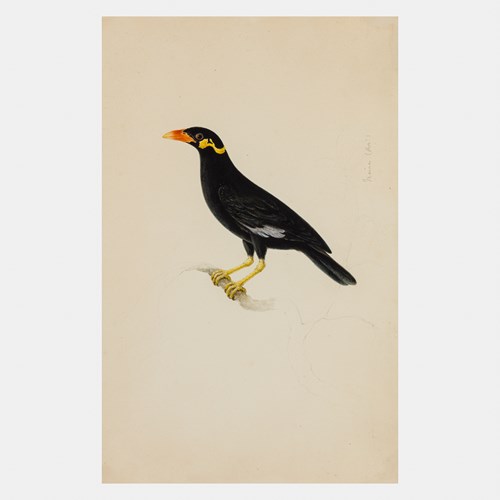Portrait of Sultan Bayezid II
Period Late 17th or early 18th century
Medium Oil on vellum
Dimension 16 x 9.5 cm (6¹/₄ x 3³/₄ inches)
Period: Late 17th or early 18th century
Medium: Oil on vellum
Dimension: 16 x 9.5 cm (6¹/₄ x 3³/₄ inches)
Provenance: Private European collection prior to 1963
Literature: This intimate portrait of the Ottoman Sultan Bayezid II (r. 1481-1512) both reveals the complexity of artistic exchange between Istanbul and the rest of Europe, which stemmed from the Renaissance, and it also sensitively evokes the personal nature of the Sultan himself.
Kneeling on an elaborate carpet, Sultan Bayezid appears resplendent in a sixteenth century sultanic dress. Bearing no royal aigrette, his taj (“scholar’s turban”) befits the ruler’s pious nature. An exquisite green kaftan adorned with stylized tughra motifs in gold thread is worn under a sumptuous forest green kurdi (“robe”), with a broad ermine collar and trim. The Sultan rests against a rich amber cushion embroidered with gold floriated motifs, reflecting the aesthetic of his belt. His greying beard suggests Bayezid’s advancing maturity, and his complexion belies that of an elderly man. The painter’s delicate natural shading creates a sense of depth and subtlety on his face, while carefully delineated arching brows, high cheekbones and chestnut eyes characterise his features.
Though partially worn, the inscription appears to read ‘V Sultan Payasit Han’. The initial V was most likely followed by ‘III’ indicating that he was the eighth Ottoman Sultan. During the seventeenth and eighteenth centuries, images of the Sultans were much sought after to adorn the walls of European castles and palaces. Portraits and manuscripts depicting the sultans were given to ambassadors visiting the Ottoman court.
In 1553 the earliest known printed collection of sultan portraits, with individually identifiable features, was produced by Guillaume Rouillé in Lyons. Printed in several languages, Promptuarium Iconum became a principal source of sultanic iconography in sixteenth century Europe. In 1579 a series of oil portraits of the Sultans, attributed to the workshop of Paolo Veronese, was sent from Italy to Istanbul at the request of Sultan Murad III (r. 1574-1595). The paintings appear to be predominantly influenced by Rouillé’s illustrations. Both series depict Bayezid II as an elderly man with a tapering beard and wearing European costume. As the oil paintings arrived in Istanbul, court historiographer Seyyid Lokman and artist Nakkaș Osman were tasked by Murad III to record the appearances of the earlier Ottoman Sultans in a manuscript. Within the completed 1579 Sema’ilname, Lokman’s biographies appeared beneath Nakkaş Osman’s portraits. Representing the personality of the sultans marked an innovation in Ottoman manuscripts and Nakkaş Osman’s images shaped the canon for sultan portraits until the end of the eighteenth century. Bayezid II’s portrait is a clear prototype for the present work. The Sultan kneels on a carpet against a red cushion and wears a scholar’s turban and green robes, embellished with gold and folds that reveal the red lining of his tunic. Notable differences are the brown trim of his kaftan, blue belt and his depiction as a young man.
Throughout the seventeenth and early eighteenth centuries, manuscripts reflected the influence of Nakkaş Osman’s portrayal of Bayezid II and depictions of him as an older ruler emerged. Levni Abdülcelil Çelebi was the court painter under Sultan Mustafa II (r. 1695-1703) and Ahmet III (r. 1703-1730). An accomplished and renowned artist, he was influenced by European painters who visited the court, particularly the Flemish-French artist Jean Baptiste Vanmour (1671-1737). Levni’s illustration of Bayezid II for a 1703 Silsilename (“Book of Genealogy”) manuscript presents him leaning against a red cushion on a patterned carpet. He wears a green kaftan with ermine trim and his grey beard is more akin to the present painting. Levni’s works sought to present the true characters of the sultans and his style had a great impact on their depictions amongst Ottoman and European artists. He provided a series of sultan portraits for Demetrius Cantemir which were subsequently engraved by Claude du Bosc for Cantemir’s book, The History of the Growth and Decay of the Ottoman Empire,’ published in London in 1734. Despite the fact that almost two hundred years had elapsed, Du Bosc’s illustration of Bayezid II still referenced Nakkaş Osman’s portrayal of him, combined with that of Levni. The Sultan is once more presented in three-quarter profile, kneeling against a cushion. His kaftan bears an ermine collar and he is wearing a taj. Although variations occur in his eyes, ermine belt and in his fuller figure, his high cheekbones, gently arching nose and grey beard are all similar to the present portrait.
The artist of the current painting must have been familiar with elements of this multifarious amalgamation of Bayezid II imagery. The work may well have been part of a portrait series and would certainly have belonged to a notable individual.
If paintings evoke the spirit of their subjects, this one truly succeeds in conveying the essence of a pious, intelligent ruler, known by his people as “Bayezid the Just”. Possessing all the attributes of an adept leader, he inherited a bankrupt state and faced civil unrest, yet by the end of his reign the empire had expanded, the state treasury was full and citizens experienced greater wealth.
Further Literature:
Nurhan Atasoy and Lale Uluç. 2012. Impressions of Ottoman Culture in Europe: 1453 –1699. İstanbul: Turkish Cultural Foundation.
Robert Born, Michal Dziewulski, and Guido Messling, (eds.). 2015. The Sultan's World: The Ottoman Orient in Renaissance Art. Ostfildern: Hatje Cantz.
Stefano Carboni. 2006. Venise et L’Orient : 828-1797. Paris: Gallimard.
Aikaterini Dimitriadou. 2000. The Hest Bihist of Idris Bidlisi: the Reign of Bayezid II (1481-1512) Ph.D, The University of Edinburgh.
Selim Kangal (ed.). 2000. The Sultan's Portrait: Picturing the House of Osman. İstanbul: İşbank.
J.M. Rogers. 1995. Empire of the Sultans: Ottoman art from the collection of Nasser D. Khalili. Geneva: Musée Rath.
Haydn Williams. 2014. Turquerie: An Eighteenth Century European Fantasy. London: Thames and Hudson.
More artworks from the Gallery




_T638497236879872479.jpg?width=500&height=500&mode=pad&scale=both&qlt=90&format=jpg)




